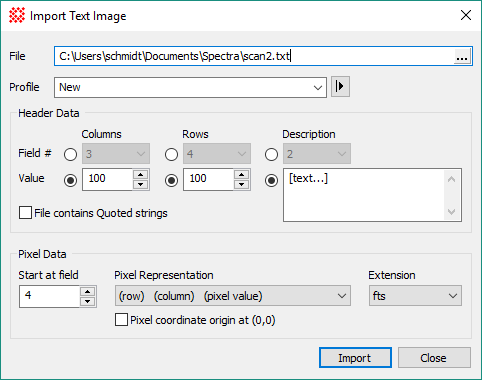|
|
The Import Text Image command opens an image in which the pixels are stored as ASCII text fields separated by "white space" (any sequence of tabs, spaces, and new-lines). This command can import "traditional" images that contain every pixel value as well as sparse images in which the values are not all of the possible pixel coordinates.
Import Text Image Properties
Comments on Importing Text ImagesThe file contents are assumed to consist of values separated by white-space (spaces, tabs, new lines). Each separated value is termed a "field", beginning with field number 1, then field 2, etc. Like the pixel values, the image Properties (columns, rows, etc.) may be read from fields in the file, or they may be specified directly. The number of columns and rows and the image description can be read from the file or entered explicitly. The selection is made by clicking the bullet for Field# or Value for each parameter. For example, the number of image columns may be stored in field 3 (the 3rd field after the beginning of the file) or you may set it to a value like "256" if the image has 256 columns. The image description is also read from the file or entered manually. If read from the file, be careful that you count each word as a field unless the description string is quote-delimited, like "this is a quote delimited string". If the description is quote delimited, then the entire string inside the quotes is considered to be a single field. Importing Sparse ImagesBy selecting the appropriate Pixel Representation option, this command can read images consisting of sequential pixel values or sparse images. The term "sparse" is taken from matrix terminology, and the image is considered a matrix of pixel values at (column,row) coordinates. A sparse image may be imported from a text file which contains coordinate information so that the pixel values may be assigned to their appropriate positions in the image matrix. To import an image as "sparse", you must select one of the Pixel Representations that includes the coordinate along with the pixel value. The imported sparse image will have a background matrix of 0-value into which is inserted the pixel values read from the file. Related Topics
Mira Pro x64 User's Guide, Copyright Ⓒ 2023 Mirametrics, Inc. All
Rights Reserved. |


